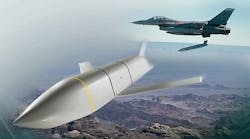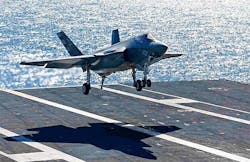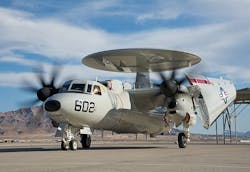Next year's DOD budget makes substantial cuts in military procurement; aircraft buying hit hard
Total procurement in the fiscal 2018 DOD budget is $125.2 billion, which is down 6.2 percent from 2017 levels of $133.5 billion. Federal fiscal year 2018 begins next Oct. 1.
The military procurement budget pays for production of ships, aircraft, ground vehicles, communications systems, sensors, and other defense platforms and technologies that are in production. Procurement spending is separate from research, operations, construction, and military personnel costs.
Planned procurement spending for all military services and agencies will be down next year. The Army's 21.2 fiscal 2018 budget, compared to 2017 outlays, is down by 11.3 percent; the Navy is down by 6.2 percent, the Air Force is down by 2.2 percent, and defense agencies are down by 16.9 percent.
DOD aircraft procurement next year will be cut by nearly one-quarter, compared with 2017 funding levels. Pentagon leaders are asking for a total of $36 billion for aircraft next year, which is down by 23.9 percent from 2017.
There is a variety of reasons that military spending accounts can change substantially from year-to-year, such as several programs reaching their ends, or a realignment that reflects changing defense priorities.
This is President Donald Trump's first military budget submission, and the new administration is compensating for procurement cutbacks with large increases in the Pentagon's research, development, test, and evaluation (RDT&E) budget. The overall DOD budget next year is $639.1 billion, which represents an 8.9 percent increase over this year's request of $586.7 billion, and is the largest DOD topline budget request since 2012.
For 2018, the U.S. Army's aircraft procurement budget is $4.6 billion, which is down 40.3 percent from 2017's $7.7 billion; the Navy's aircraft procurement budget is $15.2 billion, down $30.2 billion from 2017's $21.8 billion; and the Air Force's aircraft procurement budget is $16.2 billion, down 9 percent from 2017's $17.8 billion.
The Pentagon's 2018 procurement budget for missiles and weapons, meanwhile, is $9.3 billion, which is up 14.1 percent over 2017's $8.2 billion. In this account the big winner is the 2018 Army missile procurement budget, which is $3.1 billion, which is up 65.1 percent over 2017's $1.9 billion.
In service-specific procurement accounts, the Army's 2018 procurement budget for weapons and tracked combat vehicles is $3.6 billion, which is up 13.5 percent over 2017's $3.2 billion; the Navy's 2018 procurement budget for shipbuilding and conversion is $19.9 billion, which is up 2.8 percent from 2017's $19.4 billion; and the Air Force 2018 space procurement budget is $3.4 billion, which is up 19.4 percent from 2017's $2.8 billion.
Highlights of the 2018 Army aircraft procurement budget include $446 million to buy 13 new AH-64E Apache attack helicopters; $935.9 million to rebuild 63 Apache helicopters; $220.4 million to buy six CH-47 Chinook heavy-lift helicopters; $164.8 million for 11 MQ-1C Gray Eagle unmanned aerial vehicles (UAVs); and $1 billion to buy 48 new UH-60 Black Hawk helicopters.
Highlights of the Navy 2018 aircraft procurement budget include $3.7 billion for 24 F-35B and F-35C joint strike fighters; $809.5 million to buy five new E-2D Advanced Hawkeye carrier-based radar surveillance aircraft; $720.5 million for 22 new Marine Corps AH-1Z Viper and UH-1Y Venom helicopters; $1.4 billion for seven new P-8A Poseidon maritime patrol aircraft; $714.7 million for four new Marine Corps CH-53K heavy-lift helicopters; $636.3 million for three MQ-4C Triton maritime patrol unmanned aircraft; $706.7 for six V-22 Osprey tiltrotor aircraft; $86.2 million for four RQ-21 Blackjack unmanned surveillance aircraft; and $1.3 billion for 14 new F/A-18 E/F Super Hornet jet fighter-bombers.
Highlights of the Army 2018 missiles procurement budget include $118.2 million for 572 Javelin Advanced Anti-Tank Weapon System-Medium; $372.9 million for 3,925 Hellfire missiles; and $787 million for 6,000 Guided Multiple Launch Rocket System (GMLRS) munitions.
Highlights of the Navy 2018 missiles procurement budget include $1.1 billion to develop advanced Trident II ballistic missile modifications to improve the systems arming, fuzing, and firing systems; $58.6 million for 60 rolling airframe missile systems; $546.1 million for 125 Standard Family of Missiles; $243.5 million to buy 100 Tactical Tomahawk cruise missiles; $197.1 million for 120 Advanced Medium-Range Air-to-Air Missiles (AMRAAM); $164.2 million for 7,209 Joint Direct Attack Munitions (JDAM); $79.7 million for 184 AIM-9X air-to-air missiles; and $74.7 million for 15 Long-Range Anti-Surface Warfare Missiles (LRASM).
Highlights of the Air Force and Joint Services 2018 missiles procurement budgets include $88.3 million to buy 30 B61 tail kit assemblies for nuclear gravity bombs; $304.3 million for 205 AMRAAM missiles; $125.4 million for 310 AIM-9X air-to-air missiles; $441.4 million for 360 Joint Air-to-Surface Standoff Missiles (JASSM); $710.1 million for 27,320 Joint Direct Attack Munitions (JDAM); $356.9 million for 7,312 Small Diameter Bombs; and $332.4 million for 3,629 Hellfire missiles.
Other highlights of the 2018 DOD procurement budget include $1.1 billion to upgrade 56 Army M1 Abrams main battle tanks; $5.4 billion for two Navy Virginia-class fast-attack submarines; $3.7 billion for two Navy Arleigh Burke-class destroyers; and $1.6 billion for three Air Force Evolved Expendable Launch Vehicles.
Learn more: search the Aerospace & Defense Buyer's Guide for companies, new products, press releases, and videos


